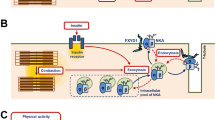Abstract.
The AMP-activated protein kinase (AMPK) is a metabolite sensing serine/threonine kinase that has been termed the master regulator of cellular energy metabolism due to its numerous roles in the regulation of glucose, lipid, and protein metabolism. In this review, we first summarize the current literature on a number of important aspects of AMPK in skeletal muscle. These include the following: (1) the structural components of the three AMPK subunits (i.e. AMPKα, β, and γ), and their differential localization in response to stimulation in muscle; (2) the biochemical regulation of AMPK by AMP, protein phosphatases, and its three known upstream kinases, LKB1, Ca2+/calmodulin-dependent protein kinase kinase (CaMKK), and transforming growth factor-β-activated kinase 1 (TAK1); (3) the pharmacological agents that are currently available for the activation and inhibition of AMPK; (4) the physiological stimuli that activate AMPK in muscle; and (5) the metabolic processes that AMPK regulates in skeletal muscle.
Similar content being viewed by others
Author information
Authors and Affiliations
Corresponding author
Additional information
Received 04 May 2008; received after revision 14 June 2008; accepted 14 July 2008
Rights and permissions
About this article
Cite this article
Witczak, C.A., Sharoff, C.G. & Goodyear, L.J. AMP-activated protein kinase in skeletal muscle: From structure and localization to its role as a master regulator of cellular metabolism. Cell. Mol. Life Sci. 65, 3737–3755 (2008). https://doi.org/10.1007/s00018-008-8244-6
Published:
Issue Date:
DOI: https://doi.org/10.1007/s00018-008-8244-6




